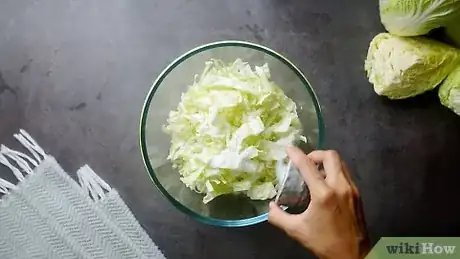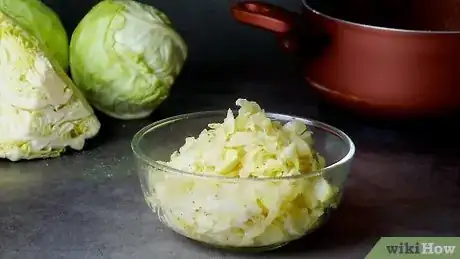This article was co-authored by wikiHow staff writer, Jessica Gibson. Jessica Gibson is a Writer and Editor who's been with wikiHow since 2014. After completing a year of art studies at the Emily Carr University in Vancouver, she graduated from Columbia College with a BA in History. Jessica also completed an MA in History from The University of Oregon in 2013.
The wikiHow Culinary Team also followed the article's instructions and verified that they work.
This article has been viewed 630,358 times.
Learn more...
If you crave the distinctive flavor of sauerkraut, learn to make the fermented cabbage at home. Plan ahead if you'd like to ferment the sauerkraut in the traditional manner. Pound shredded cabbage that you've salted until it makes a brine. Then seal and store the sauerkraut for about 2 weeks at room temperature before you enjoy it. If you're short on time, make a quick sauerkraut by boiling shredded cabbage with vinegar and spices. Use the hot sauerkraut immediately or chill it for up to 2 weeks.
Ingredients
- 2 green cabbages weighing about 4 1⁄2 pounds (2.0 kg), shredded
- 3 tablespoons (50 g) of fine ground salt
- 2 tablespoons (15 g) of caraway seeds (optional)
Makes almost 8 cups (1.2 kg) of sauerkraut
- 1 cup (240 ml) of water
- 1 cup (240 ml) of distilled white vinegar, divided
- 1/2 of an onion, diced
- 1 head of cabbage, cored and shredded
- 3/4 teaspoon (4 g) of sea salt
- 1/2 teaspoon (1 g) of celery seeds
- 1/2 teaspoon (1 g) of onion powder
- 1/2 teaspoon (1 g) of garlic powder
- Ground black pepper to taste
Makes 8 servings
Steps
Traditional Sauerkraut
-
1Toss the shredded cabbage with salt. Put 4 1⁄2 pounds (2.0 kg) of shredded green cabbage into a large bowl. Add 3 tablespoons (50 g) of fine ground salt and use a spoon to mix the cabbage.[3]
- If you prefer to calculate the ratios of cabbage and salt needed instead of going off a measurement, weigh your cabbage and add about 2% of the cabbage's weight in salt.
- You'll need about 2 large heads of cabbage to get 4 1⁄2 pounds (2.0 kg) of shredded cabbage.
- If you don't have fine ground salt, use kosher or pickling salt as long as they don't have additives such as iodine or anti-caking agents. These would make the brine cloudy and make fermentation difficult.
-
2Massage the cabbage and let it rest for 10 minutes. Use your fingers to rub the cabbage as though you're massaging it. Keep doing this until the cabbage begins to feel wet. Then set it aside for 10 minutes.[4]
- You can clean your storage jar while the cabbage is resting. Wash it with hot, soapy water or run it through the dishwasher to ensure it's clean.
Advertisement -
3Pound the cabbage for 5 to 10 minutes. Take a pounder such as the end of a rolling pin, a tamper, or a pestle and push down firmly on the cabbage. Keep doing this until the cabbage starts dripping salty water when you scoop it up. You'll need this brine to ferment the cabbage.
- If you prefer, transfer the salted cabbage to a mixing bowl and beat the cabbage with a dough hook attachment for 2 to 3 minutes.
-
4Mix in the caraway seeds and pack the cabbage into your clean jar. If you'd like to add caraway seeds to your sauerkraut, stir 2 tablespoons (15 g) of caraway seeds at this point. Spoon all of the cabbage into a clean 68-ounce (2 liter) jar and pour the brine into it.
- You may have to use the pounder to push all of the cabbage into the jar. There should be at least 2 inches (5.1 cm) of headspace at the top of the jar.
-
5Cover the top of the cabbage with a leaf or lid and weigh it down. The shredded cabbage must remain submerged in the brine so you'll need to keep it pushed down. Lay a whole cabbage leaf or a canning lid that fits in the jar on top of the shredded cabbage. Then place a sterilized rock or weight on the leaf or lid.
- To sterilize a rock, boil it for 10 minutes and let it cool.
- To add additional flavor, you could weigh the cabbage down using a half of an onion.
-
6Seal the jar. Purchase a small airlock system that screws onto the top of your jar. You can find these at home brewing and fermentation supply stores. The system will probably have a valve that lets carbon dioxide escape from the jar without letting oxygen in the jar.
- If you're using a small fermentation crock, check to see if it already has a built-in airlock system.
-
7Store the jar of sauerkraut at room temperature for 2 weeks. Place the sealed jar of sauerkraut in a cool pantry that's away from direct sunlight. The temperature in the room should be between 54 °F (12 °C) and 70 °F (21 °C). Leave the sauerkraut to ferment for 2 weeks.
- If the room is too cool, the cabbage won't ferment and if it's too hot, the cabbage will spoil.
-
8Store the jar in the fridge once you’ve achieved the desired flavor. Remove the lid and weight from the top of the sauerkraut. Dip a fork into the jar and taste a little of it. If you like the flavor, you can start eating it and storing it in the refrigerator. If you want it to have a stronger fermented flavor, seal it back up and ferment it for another week. Then check it again.
- Refrigerating the sauerkraut will stop the fermentation process. You can refrigerate the sauerkraut for up to 1 year.
Quick Sauerkraut
-
1Heat the water, 1⁄2 cup (120 ml) of vinegar, and the onion over high. Pour 1 cup (240 ml) of water into a pot on the stove. Add 1⁄2 cup (120 ml) of the distilled white vinegar and 1/2 of a diced onion. Then turn the burner to high heat.
- Keep the lid off of the pot so you can add the remaining sauerkraut ingredients.
-
2Shred the cabbage and add it to the pot. Cut 1 head of cabbage in half and cut away the core. Then place the flat sides of the cabbage halves against the cutting board. Take a sharp knife and slice the cabbage into strips that are 1⁄4 inch (6.4 mm) wide. Put the shredded cabbage into the pot with the onion and liquids.
- If you prefer, shred the cabbage in a food processor fitted with a shredding blade.
-
3Add the celery seeds, onion powder, garlic powder and vinegar. Stir 3/4 teaspoon (4 g) of sea salt, 1/2 teaspoon (1 g) of celery seeds, 1/2 teaspoon (1 g) of onion powder, 1/2 teaspoon (1 g) of garlic powder, and ground black pepper into the pot. Then pour the remaining 1⁄2 cup (120 ml) of white vinegar over the cabbage.
-
4Cover and boil the cabbage for 13 to 18 minutes. Keep the burner at high heat and put the lid on the pot. Let the cabbage boil undisturbed for 3 minutes. Then stir the cabbage and put the lid back on the pot. Continue to boil the cabbage for 10 to 15 more minutes.
- Stir the cabbage occasionally so it wilts and softens.
-
5Serve the quick sauerkraut. Turn off the burner and remove the lid from the pot. To use the hot sauerkraut, spread it over hot dogs or serve it along with sausages. If you prefer, chill the sauerkraut until it's cold and spread it on deli sandwiches. You can also serve it with a cheese board.
- Refrigerate the leftover sauerkraut in an airtight container for up to 2 weeks.
Community Q&A
-
QuestionHow much weight is necessary to keep the sauerkraut submerged?
 Community AnswerYou don't need a weight, but anything that is heavy enough to weigh it down could work. To keep it submerged without a weight, once you've crushed and pounded your sauerkraut and layered your glass or ceramic pot with the cabbage and salt, take a whole cabbage leaf or two, and place them over top. Then, depending on how much space you have left, place a shot glass or small juice glass face-up onto your kraut. Cover, and there you go.
Community AnswerYou don't need a weight, but anything that is heavy enough to weigh it down could work. To keep it submerged without a weight, once you've crushed and pounded your sauerkraut and layered your glass or ceramic pot with the cabbage and salt, take a whole cabbage leaf or two, and place them over top. Then, depending on how much space you have left, place a shot glass or small juice glass face-up onto your kraut. Cover, and there you go. -
QuestionHow long will sauerkraut last in the refrigerator and how should it be processed to can?
 Community AnswerIt will be good for two weeks or longer, just keep an eye on it for mold. To process, fill the jar to about half an inch from the top and add some of the salt water from the crock, just to cover. Have jars, lids and salt water hot first. Process for 10 minutes in a boiling water bath.
Community AnswerIt will be good for two weeks or longer, just keep an eye on it for mold. To process, fill the jar to about half an inch from the top and add some of the salt water from the crock, just to cover. Have jars, lids and salt water hot first. Process for 10 minutes in a boiling water bath. -
QuestionHow do I can my fresh sauerkraut?
 Gabriel Ben CarlingCommunity AnswerIf you want to can your sauerkraut, you need to first kill the bacteria and yeast in your sauerkraut by boiling it. Bringing it up to a simmer is all that is necessary. This will change the flavor slightly, but unless you do it, the fermentation process will continue, albeit very slowly. The fermentation releases gases, which would make canning impossible.
Gabriel Ben CarlingCommunity AnswerIf you want to can your sauerkraut, you need to first kill the bacteria and yeast in your sauerkraut by boiling it. Bringing it up to a simmer is all that is necessary. This will change the flavor slightly, but unless you do it, the fermentation process will continue, albeit very slowly. The fermentation releases gases, which would make canning impossible.
Things You'll Need
Traditional Sauerkraut
- Large bowl
- Measuring spoons
- 68-ounce (2 liter) jar
- Pounder such as a rolling pin, pestle, or tamper
- Cabbage leaf or canning lid
- Weight such as a rock
Quick Sauerkraut
- Measuring cups and spoons
- Knife and cutting board
- Pot with a lid
- Spoon
- Food processor, optional
References
About This Article
To make traditional sauerkraut, toss the shredded cabbage with salt, massage the cabbage until it starts to feel wet, and let it rest for 10 minutes. Next, pound the cabbage for 5 to 10 minutes until it's dripping salty water, then pack the cabbage and brine into a clean jar. Then, cover the top of the jar and seal the lid tightly. Finally, store the sauerkraut at room temperature for 2 weeks so it can ferment before you use it! For tips on storing fermented sauerkraut, read on!



























































